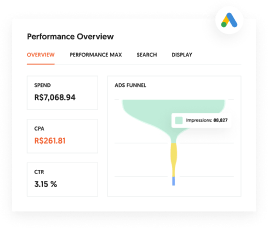
Think product sales were the only way retailers made money online? Think again.
As e-commerce and online advertising both surge in popularity, retailers have developed an ingenious new way of boosting their bottom line.
Enter retail media networks.
This new form of online advertising is incredibly popular for brands looking to reach customers at the point of purchase. Heck, it even helps customers discover new products.
But what is a retail media network? How could they benefit your business?
Let’s find out.
Key Takeaways
- Retail media networks are retailer-owned advertising platforms that run on their websites or apps.
- These networks leverage retailers’ website traffic to provide another source of revenue.
- Brands love retail media networks because they get access to valuable first-party data from retailers. Ads also reach customers at the point of purchase, making them much more effective.
- However, retail media networks give even more power to the biggest brands and retailers.
- Some of the biggest retail networks include Amazon, Walmart, Target, and CVS.
- I expect retail media to become even more popular in the future, with other retailers launching their own networks if they haven’t already.
Retail Media Network Definition
A retail media network is when retailers set up an advertising platform on their website, app, or other digital platforms within their network. This allows the store and other brands to advertise to customers on sites like CVS or Walgreens. It’s a form of in-store advertising in a digital format.
Here’s an example from CVS’s vitamins product page. Notice the “Sponsored” tag in the bottom right corner — that’s the giveaway that it’s a retail media network ad.
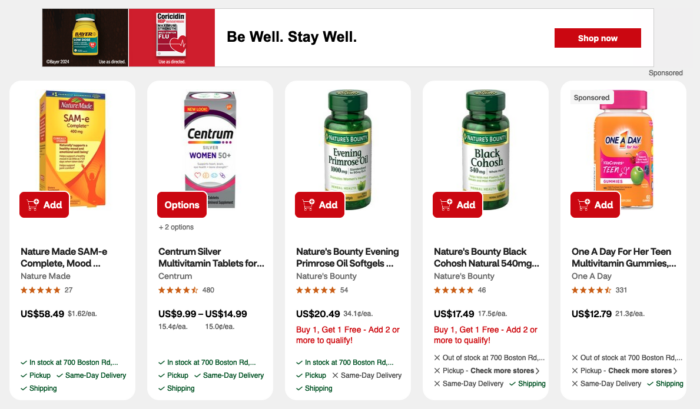
Retailers can place ads from retail media networks on several high-traffic pages, including:
- Home page
- Category pages
- Search result pages
- Product detail pages
This enables advertisers to reach shoppers at the various stages of their buyer journey and much nearer the point of sale. It’s the digital equivalent of paying for a pop-up display in a grocery store.
Benefits of Retail Media
Now you know the retail media network definition, let’s discuss the benefits of retail media networks and how they became so popular.
Their popularity shouldn’t be surprising, given the surge in e-commerce activity in the wake of the COVID-19 pandemic, which saw a 131 percent increase in online grocery sales.
Today, the U.S. online grocery customer base totals 150 million shoppers who spend more than $38 billion. Over half of U.S. internet users purchase groceries online, and 28 percent do so at least once per month.
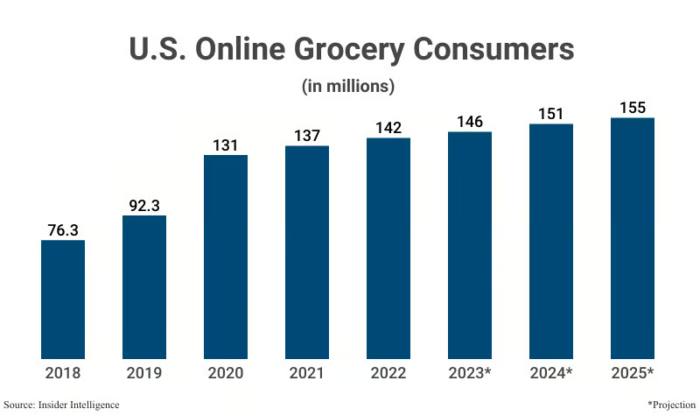
With retailers receiving so much new traffic, it didn’t take them long to realize that access to this high-quality traffic could benefit everyone, from the retailers to the brands to the shoppers.
For Retailers
Retail media networks give retailers a new revenue stream. Advertising is big business, and a retail media network enables retailers to tap into this $856 billion industry.
Profit margins on consumer packaged goods (CPG) have taken a tumble in the past few years. The revenue generated by retail media has been a lifeline for retailers looking to boost their profits.
For Consumers
Shoppers benefit from retail media in several ways.
In theory, the revenue retailers receive from these networks should allow them to offer lower prices for longer. Retailers may be less inclined to raise prices, too, given that it results in less traffic.
Secondly, retail media offers shoppers a better customer experience (CX). Sure, ads can be annoying. But if done well, they can help shoppers make better purchase decisions. They can also remind shoppers about related products they may want.
For Brands
One of the biggest advantages of retail media for brands that advertise on them is access to first-party data. In fact, it was the reason 62 percent of CPG brands worked with retail media networks in 2021.
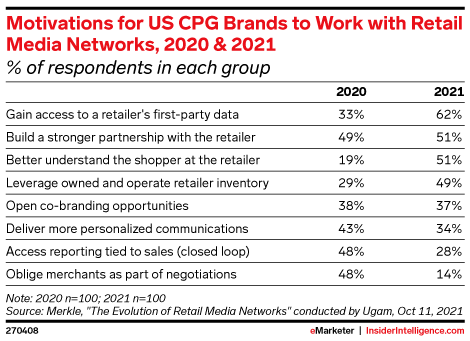
First-party data is collected and owned by the website owner; in this case, that’s the retailer. It’s clean and more reliable than third-party data collected by other methods, such as cookies. And it’s increasingly harder to get, given the impending death of cookies.
But the best part of first-party data is that it’s collected right at the point of sale, giving you better insight into buyer behavior. Why is this so important?
One word: personalization. Brands need first-party to design personalized ad campaigns that increase conversion rates.
Retail media ads also make it easier for brands to tie ad spending to sales. Because sales happen closer to the ads, it’s easier to attribute a sale to a specific ad and action. This is crucial to strategic decisions such as resource allocation.
Drawbacks of Retail Media
With retail media looking so good, could it have any disadvantages? Well, there are a couple.
One of the biggest disadvantages of retail media is that it gives even more power to the biggest brands. It creates an uneven playing field for smaller brands that don’t have the traffic, budget, and infrastructure to set up retail media networks of their own.
The platforms can also be highly competitive, resulting in higher ad costs. Research shows that even though retail media CPCs have been falling, they still average out at $0.90. For reference, the average shopping CPC across all industries is $0.66 for Google Ads and $0.46 for Bing Ads.
Further, many brands may need more expertise to navigate these platforms in-house, which will require them to hire marketing agencies.
Brands With Retail Networks
Interested in learning more about the top retail media networks and which retailers own them? Below, I cover the five brands with the biggest retail media networks.
CVS
CVS was one of the first brands to launch a retail media network, dubbed the CVS Media Exchange (CMX).
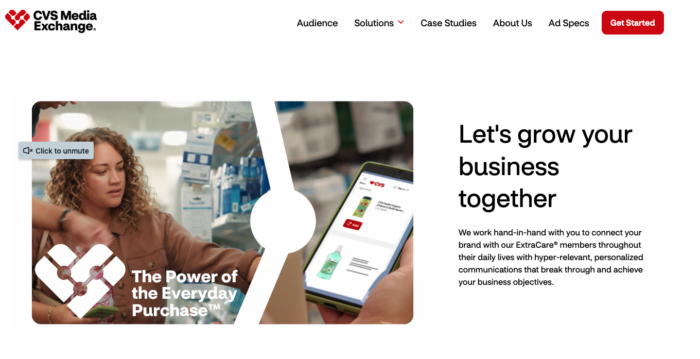
CMX allows brands to place their products on channels informed by CVS’s first data. This includes off-site as well as on-site targeted ads. When it comes to customer data, CVS has the edge over most retail ad networks, thanks to their:
- Close to 10,000 locations nationwide
- Decades of consumer data through their loyalty programs
- High-traffic online platforms
With this huge data bank at their disposal, advertisers are better equipped to create personalized ads and place them strategically for optimum visibility.
Walgreens
Walgreens isn’t green behind the ears when it comes to executing digital ad campaigns for other brands.
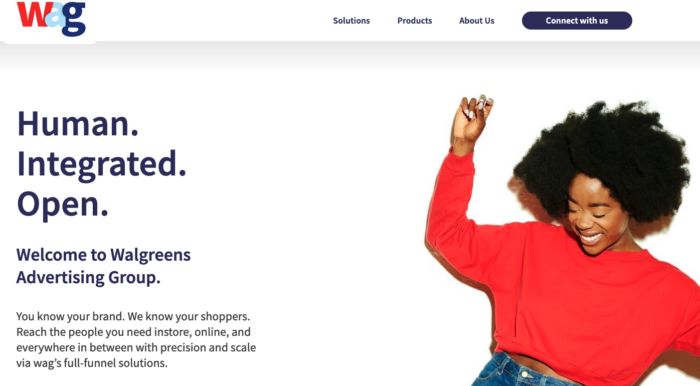
So it’s no surprise that Walgreens has decided to formalize things and launch a retail media network called Walgreens Advertising Group (wag).
wag offers ad placements on their online store, in their brick-and-mortar stores, and on other digital platforms such as social media and Google.
Amazon
Retail and e-commerce giant Amazon is the de facto leader in retail media ads, accounting for around 89 percent of all media spend through its Amazon Ads platform.
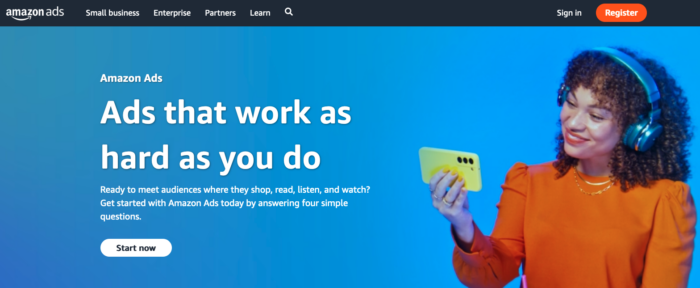
Thanks to its massive digital footprint, Amazon can offer brands more in terms of the kind of campaigns they want to run. It also gives them access to one of the world’s largest customer data banks and a massive audience (over 200 million in the U.S. alone).
Amazon Ads works much like Google Ads in that it’s a self-service platform that lets brands bid on keywords and only pay when consumers click their ads.
Amazon offers three types of ads:
- Sponsored Product ads: Product ads that appear alongside Amazon shopping results.
- Sponsored Brand ads: Larger ads that display your brand and a range of products in shopping results.
- Sponsored Display ads: Self-service programmatic ads displayed based on user behavior.
Here’s an example of a product ad:
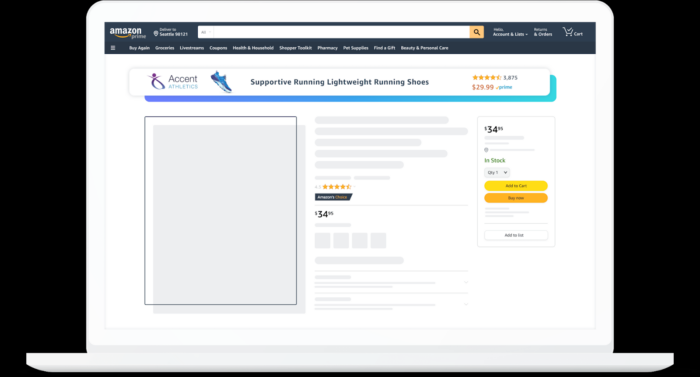
Walmart
Walmart has the country’s second-largest retail media network — although it’s a long way behind Amazon. Walmart Connect generates around $3 billion annually, while Amazon Ads brought in $12.06 billion in Q3 of 2023 alone. Walmart Connect combines Walmart’s digital and in-store reach — something that even Amazon can’t compete with.
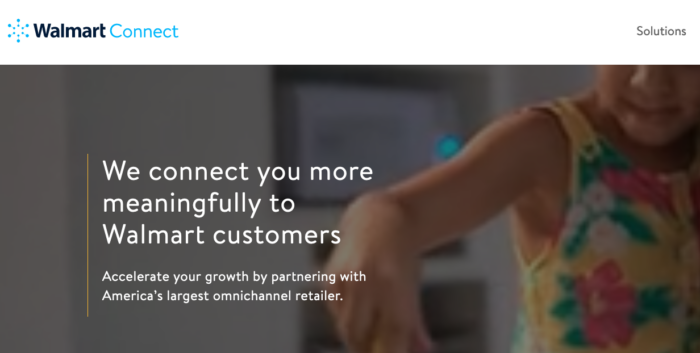
The network offers a range of advertising opportunities, including:
- Search ads featured in search result pages and browse pages
- Display ads on Walmart.com, the Walmart app, and other channels
- In-store ads across 170,000 digital TV & point-of-purchase screens
The platform even claims it can correlate online ads to online and in-store purchases
Target
Roundel™, previously called Target Media Network, is Target’s retail media platform.
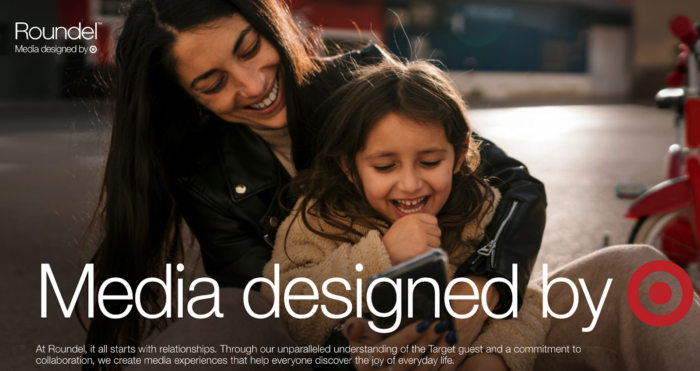
Roundel boasts insights from over 165 million Target customers and a huge range of advertising options:
- Target Product Ads: Sponsored product placements on the website and app
- Display Ads: Display ads run across the target website and 150+ partner publishers
- Search Ad: Google-based shopping ads
- Social Ads: Static, animated, and video ads on leading social networks
- CTV: Connected TV advertising
- Programmatic: Self-service programmatic advertising
- YouTube Ads: Video ad placements on YouTube
- Influencers: Co-branded influencer content on TikTok, Instagram, and Pinterest
Retail Advertising Networks
Since most retailers don’t have the infrastructure or know-how to run top retail media networks, how do they pull it off?
Most of them get external help. Here are some of the advertising networks powering the retail media movement:
Criteo
Criteo is one of the leading e-commerce advertising networks letting brands place ads on hundreds of retail websites, including:
- Costco
- Target
- Best Buy
- CVS
- Walgreens
- Staples
They make it easy for over 18,000 media buyers to purchase retail media thanks to their end-to-end service platform.
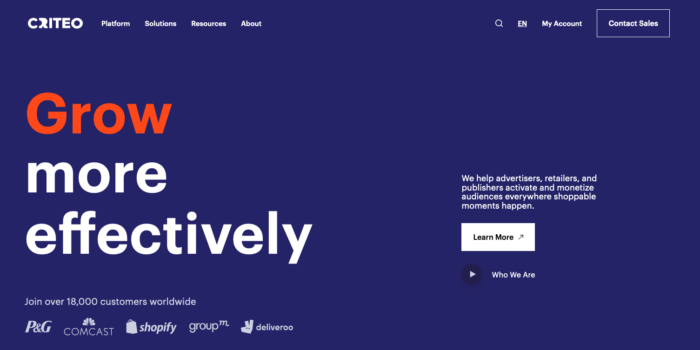
The platform gives brands and retailers full control of their campaigns and easy access to data and analytics. Robust APIs also allow you to use your marketing tool of choice.
PromoteIQ
Another advertising network that enables brands to advertise their products on retailers’ websites is PromoteIQ.
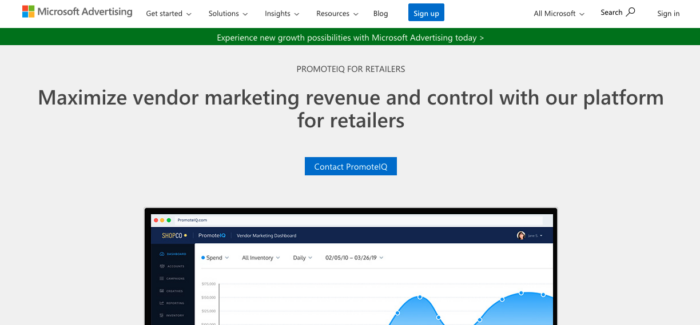
Acquired by Microsoft in 2019, PromoteIQ gives retailers full control of the end-user experience. This helps make the retail media seamlessly blend in with the retailer’s website.
PromoteIQ claims they can help retailers generate 5X their revenue by cutting out the middleman and working directly with brands through their platform. PromoteIQ also provides automation capabilities to streamline and increase your campaigns’ effectiveness.
Brands get more visibility and higher conversions thanks to PromoteIQ’s powerful data and analytics platform. This helps create hyper-targeted ads that resonate with shoppers, driving up conversions.
Instacart
Instacart is a major player in the grocery delivery market, and it’s also making waves in the retail media advertising space.
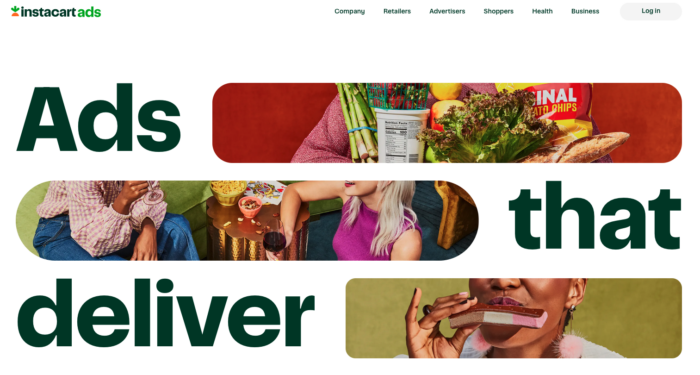
The company’s Instacart Ads platform makes it easy for brands and retailers of any size to put their products in front of millions of users, whether through a sponsored product ad, display ads, promotions, or shoppable pages.
If that weren’t enough, Instacart also partners with existing retailers, allowing them to piggyback off its technology to create their own retail media network. The platform is called Carrot Ads, and it’s already used by leading retailers like Sprouts Farmers Market.
Retail Advertising Networks Trends
Looking ahead, I expect the following retail media network trends to come to the fore.
Retail Media Advertising Spend Will Surge
I don’t expect the growth of retail media ads to stop any time soon. In fact, Insider Intelligence predicts U.S. retail media ad spending will more than double between 2023 and 2027— and reach $109.40 billion by 2027.
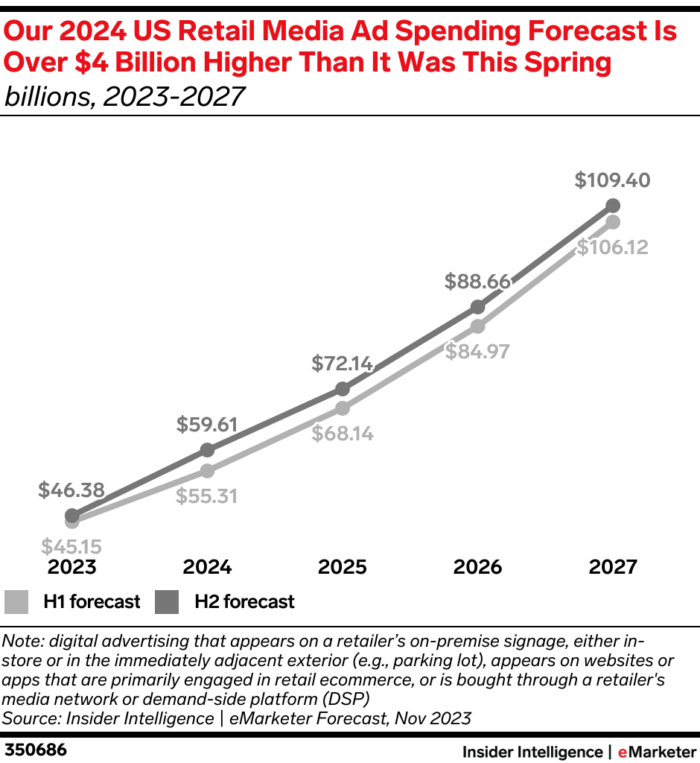
Why?
Well, it’s partly due to the benefits I’ve mentioned above (access to first-party data and better attribution). But it’s also because it’s becoming harder and more expensive to win on traditional digital marketing channels like search and social.
Take appearing in Google, for instance. The search giant spent 2023 quietly increasing paid ad costs while also launching nine algorithm updates — making it one of the most turbulent years ever.
More Retailers Will Launch Their Own Networks
All of the top 10 retailers, as listed by the National Retail Federation, have their own retail media network, and I believe many smaller retailers will join them. After all, who wants to miss out on the retail media gold rush?

It won’t just be grocery stores offering them, either. Retailers in diverse categories, from electronics to beauty (like Ulta), will launch niche networks to cater to thousands of brands.
In-store Retail Media Will Become Just as Popular
If so many leading retailers already have digital media networks, what next? The answer lies in store.
I expect retailers to start digitizing the in-store experience, offering ad space at key points around the store that allow brands to run full-funnel marketing campaigns. Some retailers have already started bringing digitized ads into the store or at the gas pump.
Luckily for retailers, though, there’s no shortage of in-store space that can be turned into ads:
- Cooler screens
- Front-of-store signage
- Shelf labels
- End caps
In fact, retailers will have to be careful they don’t overwhelm customers with ads.
FAQs
What is a retail media network?
A retail media network is a retailer-owned advertising platform that runs on their website or app. It allows brands to connect with consumers at the point of purchase and access reams of valuable first-party data. Examples include Amazon Ads, Walmart Connect, and CMX by CVS.
Why are retail media networks important?
Retail media networks are important because they allow brands to advertise to consumers at the point of purchase. Adverts feel much more relevant to online shoppers, too, providing valuable insights into shopper behavior and helping brands tailor products and messaging to serve their audience better.
What are the benefits for brands?
There are several benefits of retail media networks for brands, including:
- Access to retailers’ first-party data, including information from loyalty programs.
- The ability to leverage existing relationships between brands and retailers.
- Enhanced ROI, with advertising in retail media networks reaching customers in a buying mindset, often resulting in significantly higher returns compared to other channels.
How is performance measured?
Performance in retail media networks is measured using retail media measurement tools to track key performance indicators such as conversion rate, return on ad spend (ROAS), and cost per click (CPC). These metrics help brands assess the effectiveness of their campaigns and optimize ad spend.
The focus on data-driven insights leads to more sophisticated personalization strategies, enabling brands to create highly tailored ad campaigns that resonate with their target audience.
Conclusion
Retail media networks offer fantastic opportunities to brands and retailers alike.
If you’re a brand, the right retail media network will let you tap into highly targeted audiences you simply can’t reach alone. They can also help you maximize your marketing budget, ensuring you get the best ROAS.
If you’re fortunate enough to have your own e-commerce retail site, then use one of the tools above to create your own retail media network. After all, they have the infrastructure in place to get your retail network up and running quickly. Which means you’ll have more time to spend on your business. It’s easy, too, and similar to signing up for a programmatic ad platform.
In either case, let me know your experience with media retail networks in the comments.
Have you used retail media for your brand? What was your experience like?

See How My Agency Can Drive More Traffic to Your Website
- SEO - unlock more SEO traffic. See real results.
- Content Marketing - our team creates epic content that will get shared, get links, and attract traffic.
- Paid Media - effective paid strategies with clear ROI.
Are You Using Google Ads? Try Our FREE Ads Grader!
Stop wasting money and unlock the hidden potential of your advertising.
- Discover the power of intentional advertising.
- Reach your ideal target audience.
- Maximize ad spend efficiency.

